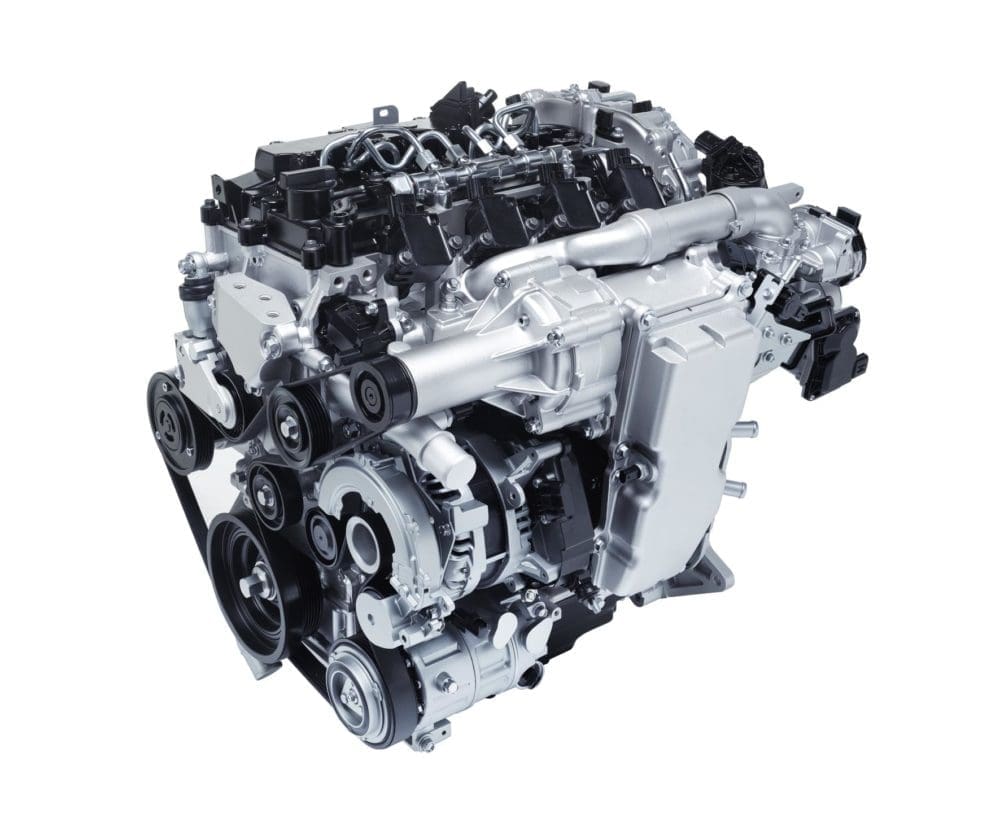



Mazda believes that when converted to a ‘Well-to-Wheel’ figure, the average CO2 emissions of an EV can be very close to a conventional vehicle depending on the energy mix the electricity is made from, so it says it is focusing on bettering the real-world emissions of EVs by maximising the efficiency of the internal combustion engine. Accordingly, Mazda has been looking to significantly reduce CO2 emissions from petrol engines based on the analysis of combustion control factors. One of the key control factors is the use of a highly lean mixture of air and fuel: 2-3 times leaner than in today’s conventional engines. This mixture has so little fuel in the air that a normal engine with spark plugs cannot fire it.
Mazda already uses uniquely high compression ratios on its current SKYACTIV petrol engines to reduce fuel consumption, so this lead to the idea of increasing the compression ratio even further and igniting the fuel simply by compression as is the norm in modern diesel engines. However, in past decades this approach has been researched several times by various Original Equipment Manufacturers without development moving beyond the laboratory; the problem being the very small operating area in which a stable and predictable combustion was achievable.
So Mazda rethought the whole process and developed its own proprietary combustion method – Spark Controlled Compression Ignition (SPCCI) and the company’s new 2.0 litre SKYACTIV-X engine that uses this process.
With SPCCI, the engine injects a lean air-fuel mixture, compressing it up to 16:1 which is just below the level required to achieve compression ignition. To ignite the mixture at the right time, a small injection of atomised fuel directly around the spark plug builds a richer core. When fired, this small core creates a pressure wave that runs through the combustion chamber, increasing the compression and temperature to the critical point where the main body of fuel combusts. The power variation can be controlled via the aspired first charge and by a second charge injected shortly before the piston has reached its optimal position. This greatly extends the area of lean operation and promotes very high fuel economy. Conventional combustion is used only at high engine loads and during very cold starts.
By controlling the compression ignition with a spark plug, the issues of knocking and unstable combustion can be avoided, achieving a seamless transition between compression ignition and spark ignition. According to Mazda, this means the engine can run more than 80 per cent of time in a very efficient mode. In areas where low vehicle speeds are used frequently, fuel economy can be improved by up to 30 per cent and CO2 emissions reduced by a corresponding amount thanks to the use of super lean combustion. Compared to the MZR engine of 2008, fuel economy is improved a claimed 35-40 per cent, and SKYACTIV-X even equals or exceeds Mazda’s latest SKYACTIV-D diesel engine in fuel efficiency.
With improvements being especially great in the light engine load range, Mazda says SKYACTIV-X challenges the commonly-held belief that medium petrol engines have poor fuel economy in cities. The company says the range within which the engine is able to deliver excellent fuel economy has been dramatically expanded with the use of the SKYACTIV-X, meaning that this system is able to deliver lower fuel consumption than ever before in a wide range of driving scenarios, including both urban and long-distance motorway driving.
© Motorworld Media 2023
Registered Office: 4 Capricorn Centre, Cranes Farm Road, Basildon, Essex. SS14 3JJ
Company Number: 8818356
Website designed by Steve Dawson